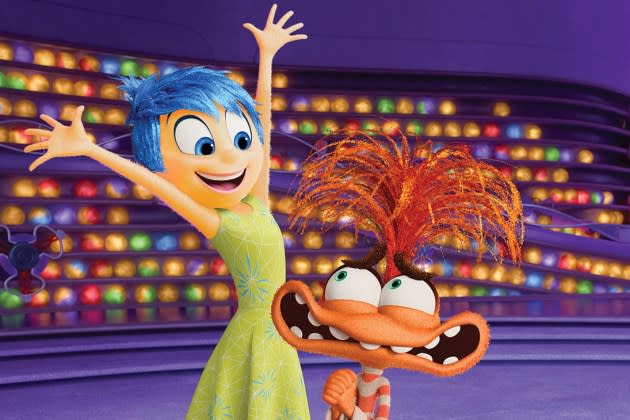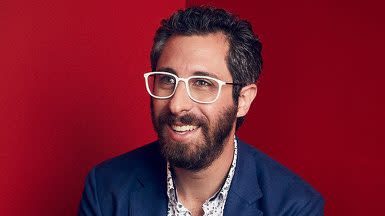‘Inside Out 2’ Writer Reflects on the Anxiety of Writing a Movie About Anxiety

It’s a practical joke to ask a screenwriter to write about anxiety.
The very nature of the occupation is to walk around constantly asking yourself: What’s the worst thing that could possibly happen in this moment? To this character? To someone the character loves? To someone I love? To me?
More from The Hollywood Reporter
But there’s a special kind of anxiety that comes with writing the sequel to a beloved film like Inside Out. Aside from the many accolades bestowed on it — it’s a perfect film with an Oscar-nominated screenplay — it’s also my personal favorite Pixar movie.
It had been a dream of mine to write at Pixar. Six years ago I had interviewed with director Dan Scanlon to write Onward, but the timing didn’t work out when Showtime greenlit my Jim Carrey-starring series Kidding. Now, here I was again, passing beneath the giant Luxo lamp, getting the writer baton passed to me by the first movie’s author, the brilliant and incomparable Meg LeFauve, who had to leave the project to focus on a live action film she’d been working on with her husband.
Not only would I be writing in her shadow but also the incredibly long shadow of a part cat, part elephant, part dolphin who cries candy. And although the Newtonian physics inside the world of Riley‘s mind are negotiable, perhaps the one scientific truth is that Bing Bong can only die once.

So when I landed at Pixar’s campus in Emeryville there was a specific orange tang in my mouth — a flavor of anxiety created by looking up at this high bar and constantly wondering: Is the only successful version of this movie a somehow more perfect film that also has to clear $1 billion at the box office and also bring Pixar audiences back to theaters and also make you laugh and also cry and also answer a big philosophical question around minute 79 that you didn’t even know you needed? Also why is my hair turning gray? Will my six year old son watch it? Will he think it’s better than Cars? Can a movie truly compete with itself if you can only kill Richard Kind once?
Those aren’t coat hangers hanging in Anxiety’s closet. Those are question marks.
And the real question I was struggling with was: Where was Joy in all this? To really understand this sequel, I really had to answer that question. And not just in the script, but in my own life.
My father-in-law was the closest thing I had in this world to the character of Joy. He made friends in line at the grocery store. His kindness was Covid-contagious. His thick Maine accent and deep lexicon of regionally specific verbiage meant he could’ve easily pulled off a line like “jiminy mother-lovin toaster strudel” — even giving Amy Poehler a run for her money.
We lost him in January after a long battle with mesothelioma — a lung cancer brought on by asbestos exposure from working in a steam plant in his 20s, an experience he said he would repeat if given the chance because it was how he met his wife.
In the same 12 month period while writing this film I also lost the final three of my grandparents, including my grandmother, Audrey. The only reason I have a career in Hollywood is because 50 years ago she bought a house next door to the creator of Family Ties and asked if her sons could help on set.
These are sad and stressful things, and perhaps too dark of a backdrop for writing the script for an animated family film — yes, even one for Pixar, whose siphoning of humanity’s tear ducts over a generation of heartfelt moviemaking could fill a sixth Great Lake. But they helped me answer the question I needed to answer.
In the mess of life it’s hard to find Joy as an adult. As a child, somehow she’s just there. In swimming pools and berry bowls. At the ends of ice cream cones and school years. But when you’re a child you don’t know what you don’t know. You don’t know how cruel the world can be or how much energy it can take to just leave your house in the morning.
My original question of “Where is Joy in all this?” became “What happens to Joy as we get older?” Does Anxiety just take over? Does the dark stuff just add up and overwhelm you? Does the pressure to live up to the original film bury you under so many peppermints and gum drops?
As we grow up, does Joy stop driving? Is the character’s pain just that? In the last movie she discovered the value of Sadness. In this movie, does she need to see the value of herself drifting away with time? But like, in a funny way?
I remember looking over to our fearless director Kelsey Mann one day in the story room. He had more pressure on him than any of us – this was his first feature – and yet I never saw him crack once. I never saw him get angry or lose his patience or control. I saw him choose Joy. I saw him choose Joy every day.
Now Joy isn’t always a choice. And Joy is definitely not an easy thing to create. But if the process of making this film has taught me anything it’s that she begins as a choice. And as we get older, Joy becomes more valuable, not less, because of the effort it takes to make that choice.
I hope audiences, young and old, experience this film without feeling the anxiety that it took to write, but rather the joy it took our entire team to complete. And I hope they leave the theater wanting to check-in with their own Joys. Their own Anxieties. And ask them how they’re doing.
What’s the worst that could happen?
Best of The Hollywood Reporter

 Yahoo News
Yahoo News 